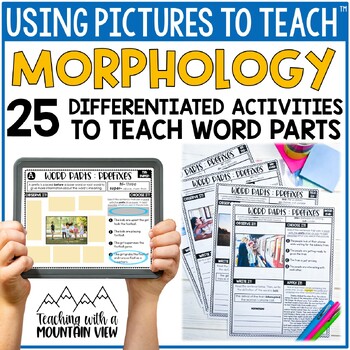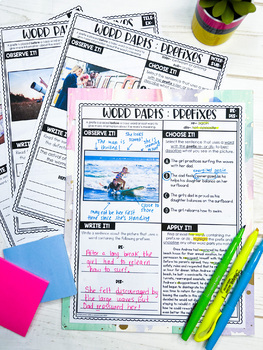Using Pictures to Teach Word Parts | Morphology Science of Reading
- Zip
- Google Apps™

What educators are saying
Description
Teach and review word parts (morphemes, morphology) in an engaging way. Your students will love learning and applying knowledge of prefixes, suffixes and root/base words to pictures, short passages, activities, and questions. This resource is the perfect supplement to your morphology study!
THREE Levels of Word Parts Included:
- Level One (10 pages) includes the following word parts:
- Prefixes: re-, dis-, pre-, non-, un-, over-, under-, in-
- Suffixes: -ful, -ing, -ed, -y, -less, -est, -er, -ly,
- Base Words: bio, photo, graph, hydr
- Level Two (9 pages) includes the following word parts:
- Prefixes: anti-, bi-, tri-, super-, quad-, multi-, mis-, oct-, auto-, semi-, fore-
- Suffixes: -ment, -ist, -able, -tion, -ology, -sion
- Base Words: chron, struct, aqua, ath, therm
- Level Three (6 pages) includes the following word parts::
- Prefixes: tele-, ex-, inter-, sub-, poly-, in-, im-, il-, ir-, mid-, micro-, trans-
- Suffixes: -ess, -ee
- Base Words: phon, manu, ast
Each Level is DIFFERENTIATED:
Each of the three levels of activities is differentiated into TWO versions:
- On Level Versions - These versions are best for grades 3 and 4. The vocabulary in the passages is more straightforward, and the activities are well-suited for on-level instruction.
- Advanced Versions - These versions are best for grades 5 and 6. These texts use advanced vocabulary and include a more difficult task of generating words with the given morphemes..
There are four components to EACH page of this resource:
- Observe It: This section includes the picture with plenty of white space around it. The white space is for students to make observations/inferences about the picture. Challenge students to include the focus morphemes in their observations/inferences!
- Choose It: This section has a multiple choice question that focuses on a specific set of word parts AND relates to the picture in the “observe it” section.
- Write It: In this section, students will write a definition of a bolded word using their new information on word parts AND context clues. (In the advanced version, students will generate a sentence about the picture using the given prefixes/suffixes/root words)
- Apply It: This section has a short story that loosely relates to the same topic shown in the picture (but does NOT represent the picture) and has students identify a selection of words using the focus morpheme.
Digital Version: This resource includes a Google Slides version optimized for digital use.
Answer Keys: Suggested answer keys are included.
Also Included:
- A morpheme analysis page for students to break down words to find their meanings
- A word parts anchor chart
- Word Part Reference Guides for each level
Looking for more ways to teach literacy using pictures? They’re right here!
Using pictures to teach reading skills




